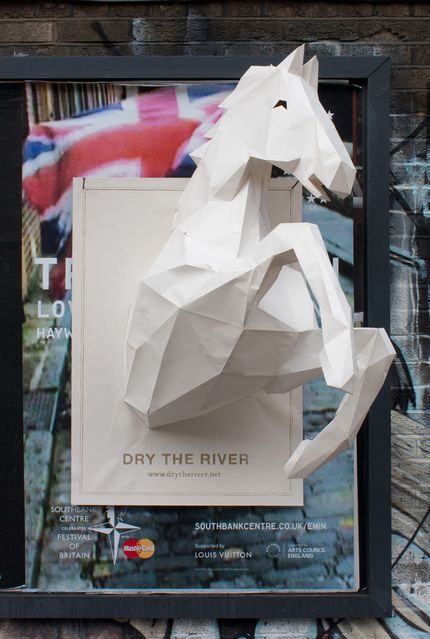I came across this a while ago and didn’t quite know what to make of it: London’s inoffensive, vaguely folk-sounding alterno-rock group Dry The River have created 3D posters to advertise their latest album.
Yeah. My first thought was, “How do they ensure that people are wearing 3D glasses when they view the posters?”
Then I saw that the posters aren’t 3D in the annoyingly ubiquitous “It looks just like Avatar!” sense. They are 3D in the “they exist in three dimensions” sense. They are not so much posters as much as they are sculptures.

3D Posters
Each poster was hand made in collaboration with French artist Xavier Barrade, taking thirty-five hours to complete one poster. Due to the large amount of time it takes to create each poster, only a few pieces were created and then each was strategically placed around London. The message then spread, or was pushed, through social networks. To close the loop on this intimate marketing solution, a time lapse video depicting the making of a poster has been used as the video clip for the band’s single “No Rest”.
So this is interesting for a number of reasons. Firstly, it recreates the notion of the band poster. Now whenever I see a sad little photocopied A4 poster in black and white, covered in tape and speckled with mud I wish I saw a majestic paper horse charging toward me.
Secondly, it puts into play the media theory espoused by Harold Innis in his 1950 text ‘Empire and Communication’. Innis postulated that societies must strike a balance between using ‘time-biased’ or ‘space-biased’ media. In this sense, ‘time-biased’ media are durable and persist through time (such as stone and clay sculptures), whereas ‘space-biased’ media are easy to transport to the reaches of an empire (such as paper and papyrus).
The scarcity of posters meant that the medium was inherently ‘time-biased’- an artisanal medium with a consistent message, deciphered by a few with the knowledge acquired offered in pedagogic structures. When social networks were used to share the existence of the posters, a ‘spatial bias’ was enacted- a message translated into the vernacular and repeated en masse in androgogic patterns. The campaign was both exclusive and inclusive. Those in the know were called upon to educate their not-so-hip friends.
Thirdly, it further blurs the lines between advertising and art in a medium that has grown stale; where Banksy is a brand name and every telegraph pole is the site of passive one-way communication.
There is, however, one problem with the band’s media strategy- Dry The River are very mediocre. They cannot escape comparisons to Noah and the Whale or Mumford and Sons for one simple reason- Dry The River are very, very mediocre. I mean, once you’ve got the fish on the hook, you actually have to reel it in.
Ammaright?!
0 Responses to “Sculpture and Social Media”